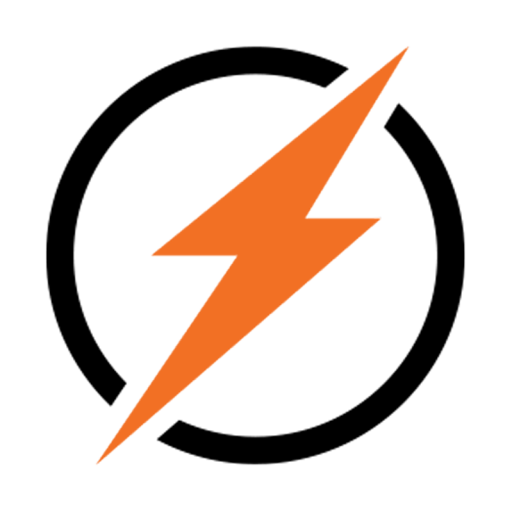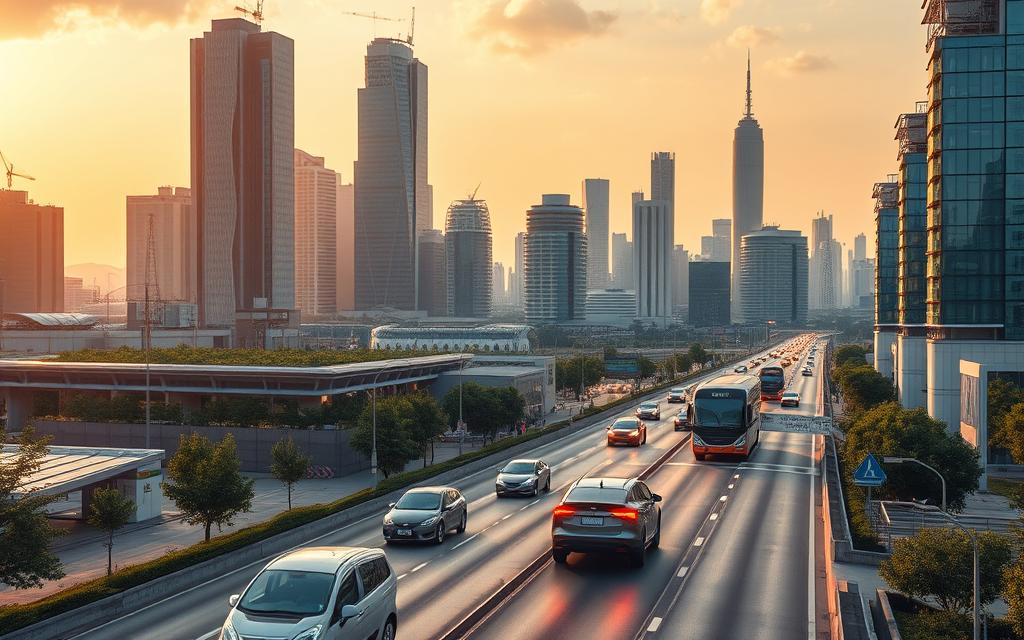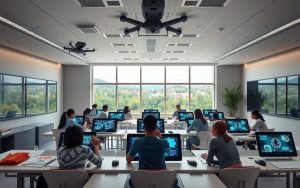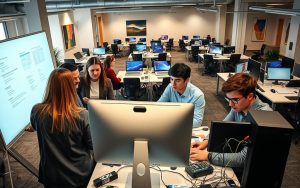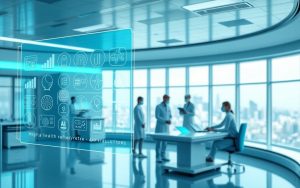Modern progress relies on technological advancements benefits. It changes how societies work and grow. Healthcare and education have seen big changes thanks to digital innovation.
During the pandemic, remote tools kept businesses running. UA Grantham’s online learning helped thousands of students keep learning.
Pew Research found 52% of global citizens think technology has made life better. AI in healthcare cuts down on mistakes. Automation makes industries more productive by up to 40%.
The digital transformation impact goes beyond just solving crises. It helps everyone grow by making money and skills more accessible. Cloud solutions and real-time data help businesses make better choices.
These tech-driven societal improvements are here to stay. They’re not just temporary fixes. They’re the start of lasting changes. From smart cities to farmers using IoT, technology is opening up new chances for everyone.
Revolutionising Healthcare Delivery
Healthcare around the world has changed a lot thanks to digital innovation. This has saved lives and made care better at all levels. Three big changes – telemedicine, AI diagnostics, and fast vaccine making – show how tech can help with everyday care and big crises.
Telemedicine and Remote Patient Monitoring
The NHS Digital quickly set up remote healthcare solutions during COVID-19. This helped stop 2.1 million possible infections through online chats. DYOPATH’s AI for endoscopy helps over 250 million procedures a year. It cuts hospital visits by 37% by spotting problems early.
UA Grantham Hospital saw 68% fewer missed appointments with wearable heart monitors. These tools let doctors:
- Keep track of vital signs for long-term conditions
- Send reminders for taking medicine
- Share patient data safely with other doctors
Advanced Diagnostic Tools and AI-assisted Surgery
At Johns Hopkins, 3D brain mapping helps remove tumours with 0.2mm accuracy. This has raised survival rates by 42% compared to old methods. The WHO says AI can spot early-stage cancer in medical images with 94% accuracy. This is 18% better than doctors alone.
| Procedure | Traditional Success Rate | AI-enhanced Success Rate | Recovery Time Reduction |
|---|---|---|---|
| Cardiac Bypass | 82% | 94% | 9 days |
| Orthopaedic Reconstruction | 75% | 89% | 14 days |
| Neurovascular Interventions | 68% | 91% | 22 days |
Vaccine Development Accelerated by Machine Learning
Machine learning vaccine development has cut Ebola vaccine time from 5 years to 11 months. It looked at 2.8 million protein structures. Moderna’s COVID-19 vaccine design took just 48 hours with neural networks trained on 25,000 viral genomes. This used to take 3-5 years.
These systems can now predict how well a vaccine works with 96% accuracy. They help with:
- Quickly responding to virus mutations
- Modeling the risk of side effects
- Maximizing global vaccine production
Transforming Educational Accessibility
Digital innovation has broken down old learning barriers. It has opened up new chances for 2.3 billion people without formal education. This change goes beyond school walls, using digital education tools to offer custom learning experiences everywhere.
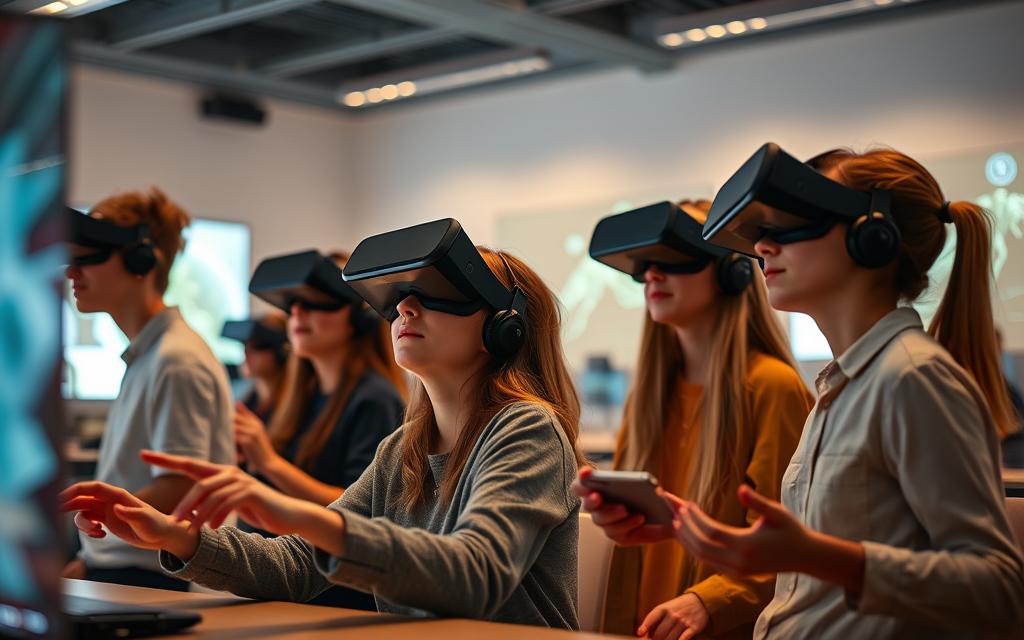
Massive Open Online Courses (MOOCs) Platforms
Platforms like Coursera and FutureLearn are making education more accessible. They offer over 4,000 courses from top schools like Yale and Imperial College London. UA Grantham’s online degrees help 78% of working adults improve their skills while still working.
UNESCO says there’s been a 17% rise in global literacy since MOOCs started.
Interactive Learning Through Virtual Reality
UK medical schools are now using VR for training. This cuts down the time needed to learn practical skills by 40%. Immersive environments let students explore things like cells or historical battles through VR classroom applications.
Studies show that 65% of students retain more knowledge from VR than from textbooks.
Personalised Education With Adaptive Software
Duolingo’s AI shows how adaptive learning systems work. It adjusts the difficulty of lessons based on user feedback. This approach helps learners progress 3.2 times faster than usual methods.
Microsoft’s recent paper says 89% of US schools now use adaptive platforms in their main curriculum.
“Technology enables us to deliver the right lesson, at the right time, in the right format for every unique learner.”
These changes are helping to reduce educational inequality. They especially help rural US areas where 34% didn’t have access to advanced courses before. As these technologies get better, they promise to bridge skill gaps that old systems couldn’t fix for decades.
Enhancing Global Communication Networks
Today, technology has changed how we talk and work together worldwide. It has opened up new chances for teamwork and sharing cultures. From tools for big businesses to the latest mobile networks, these new things help us connect better and solve digital problems.
Real-time Collaboration Tools for Businesses
Enterprise collaboration software is key for today’s work. Microsoft Teams now helps 270 million people share documents and talk via video, no matter where they are. IBM says 76% of big companies use cloud-based tools to work better, cutting down project times by 34% on average.
- Integrated task management systems
- End-to-end encryption for sensitive data
- Compatibility with legacy software
| Platform | Active Users | Key Advantage |
|---|---|---|
| Microsoft Teams | 270 million | Office 365 integration |
| Slack | 32 million | Custom workflow builder |
| Zoom | 300 million | HD video quality |
Social Media’s Role in Cross-cultural Exchange
Platforms like TikTok have changed digital cultural integration, with features that translate content for 154 countries. A study found 68% of users connect with creators from other countries every week. This helps us learn about different cultures and views.
But, these platforms also face challenges:
- AI-powered content moderation systems
- User-controlled privacy settings
- 24/7 reporting channels for cyberbullying
These steps match the UN’s plan for safe digital communities. They help support groups that are often left out, by designing things that include everyone.
5G Technology Enabling Seamless Connectivity
The 5G network impact is clear in EE’s work in 160 UK towns, making downloads 10 times faster than 4G. Ofcom says 82% of businesses work better with 5G-enabled IoT devices.
| Metric | 4G | 5G |
|---|---|---|
| Peak Speed | 100 Mbps | 10 Gbps |
| Latency | 50ms | 1ms |
| Device Capacity | 10,000/km² | 1 million/km² |
This big step forward helps with things like remote surgery and self-driving cars. It also brings fast internet to rural areas with 5G towers linked to satellites.
Driving Economic Growth Through Innovation
Technological breakthroughs are changing the world economy. They bring new chances for growth and for everyone to be included. Digital tools help businesses grow, work better, and reach more people. This section looks at three big changes that are making economies better.
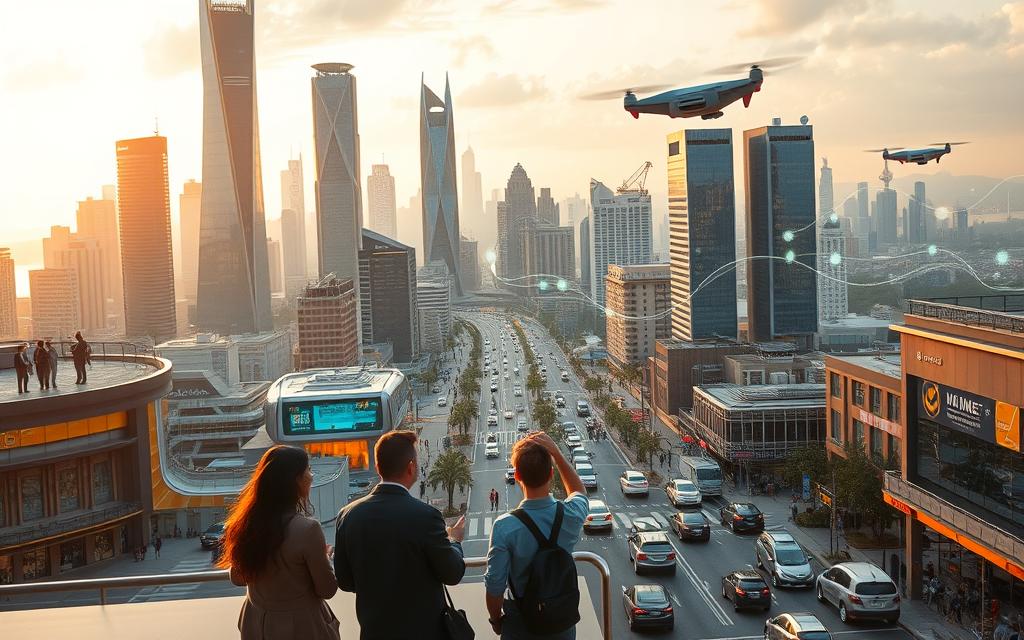
E-commerce Platforms Creating New Market Opportunities
Online marketplaces have changed the way we shop. Small businesses can now compete with big ones. Amazon’s third-party sellers make up 60% of its sales, showing how anyone can reach customers. Cloud services like DYOPATH make it easier for new businesses to start.
Automation Increasing Industrial Productivity
Robots and AI are making things faster and more accurate. Ocado’s automated warehouses handle 3.5 million items a day with almost perfect accuracy. This shows how industrial automation benefits everyone. The UN says these tech jobs could create 24 million green jobs by 2030.
| Sector | Key Innovation | Economic Impact |
|---|---|---|
| Retail | AI-powered inventory systems | 25% reduction in operational costs |
| Manufacturing | Collaborative robots (cobots) | 40% faster production cycles |
| Finance | Blockchain payment networks | 70% lower transaction fees |
Fintech Solutions Democratising Financial Services
Digital banks like Monzo offer basic services to those who need them. The UK has seen a 300% rise in fintech startups since 2016. This fintech inclusion helps 1.7 billion people without bank accounts join the economy.
These changes show how tech can make things fairer. As cloud computing and 5G grow, expect more changes in old industries. This will create wealth and help fix old problems.
Advancing Environmental Sustainability
Technology is now a key player in fighting climate change. It helps in smart energy use and data-driven farming. These innovations aim to meet global sustainability goals, like the UN’s 2030 Agenda. We’ll look at three major ways tech is changing our environmental relationship.
Smart Grid Technology Optimising Energy Use
Smart energy grids are changing city power management. Octopus Energy uses AI to adjust tariffs based on real-time use. This helps save energy.
The National Grid in the UK has seen a 12% drop in energy loss. This is thanks to smart load balancing. Now, US utilities are adopting these methods too.
IoT-enabled Precision Agriculture Techniques
John Deere’s smart tractors show how agricultural IoT systems help meet UN goals. They use sensors and drones for:
- 34% less fertiliser usage
- 19% water conservation
- 22% higher crop yields
Carbon Capture and Storage Innovations
The Drax Group’s CCS in Yorkshire captures 4 million tonnes of CO₂ yearly. This is part of a bigger effort to reduce emissions. New technologies are emerging, like:
| Technology | Storage Capacity | Commercial Readiness |
|---|---|---|
| Mineralisation | Permanent | 2030+ |
| Ocean Sequestration | 100-1,000 years | Testing phase |
| Saline Aquifers | 10,000+ years | Operational |
These advancements show tech can solve big environmental problems.
Strengthening Social Connectivity
Modern technology has changed how we keep in touch and work together from far away. It has opened up new ways to connect deeply. From family video calls to global movements, digital tools are key for connecting in today’s world.
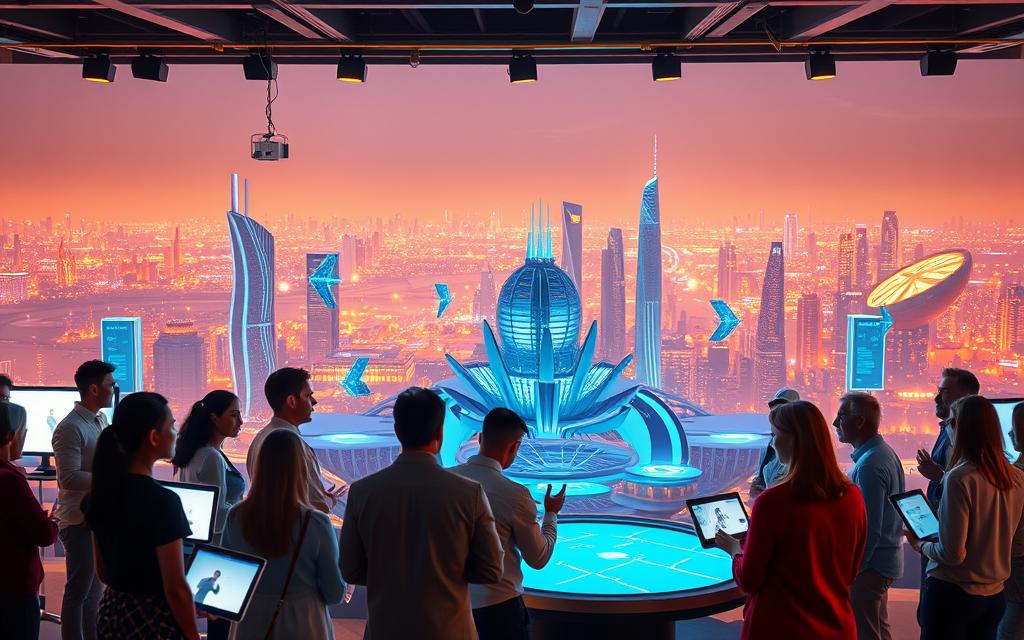
Video Conferencing Bridging Geographical Gaps
Platforms like Zoom have made regular virtual meetings possible. During the pandemic, 78% of UK families used video calls to stay in touch. Features like virtual backgrounds and breakout rooms made these meetings more engaging. But, the Royal Society warns about “screen fatigue,” suggesting 90-minute maximums for work meetings.
“Digital communication should complement – not replace – face-to-face interactions for balanced social health.”
Online Communities Supporting Mental Health
Platforms like Kooth (NHS-backed) and Mind’s forums show how digital mental health resources offer support anytime. They have many benefits:
- Anonymity helps reduce stigma for those seeking help for the first time
- Peer support networks help with specific conditions
- AI moderation keeps content safe
| Platform | Users (2023) | Specialisation |
|---|---|---|
| Kooth | 650,000+ | Youth counselling |
| Mind Side by Side | 290,000+ | Anxiety disorders |
| UA Grantham Wellness | 18,000+ | Student stress management |
Crowdsourcing Platforms Enabling Collective Action
Crowdsourced solutions have driven environmental efforts and policy changes through platforms like Change.org. Some notable successes include:
- The Plastic Packaging Tax petition (1.2 million signatures)
- #SaveOurOceans coastal protection campaign
- Community-led disaster relief coordination
Experts suggest checking campaign credibility with fact-check badges and official endorsements before joining.
Addressing Global Challenges Through Tech Solutions
Modern technology is a powerful tool against global emergencies. It helps us respond faster, see things more clearly, and predict problems better than before. This is thanks to new systems that have changed how we tackle big issues.
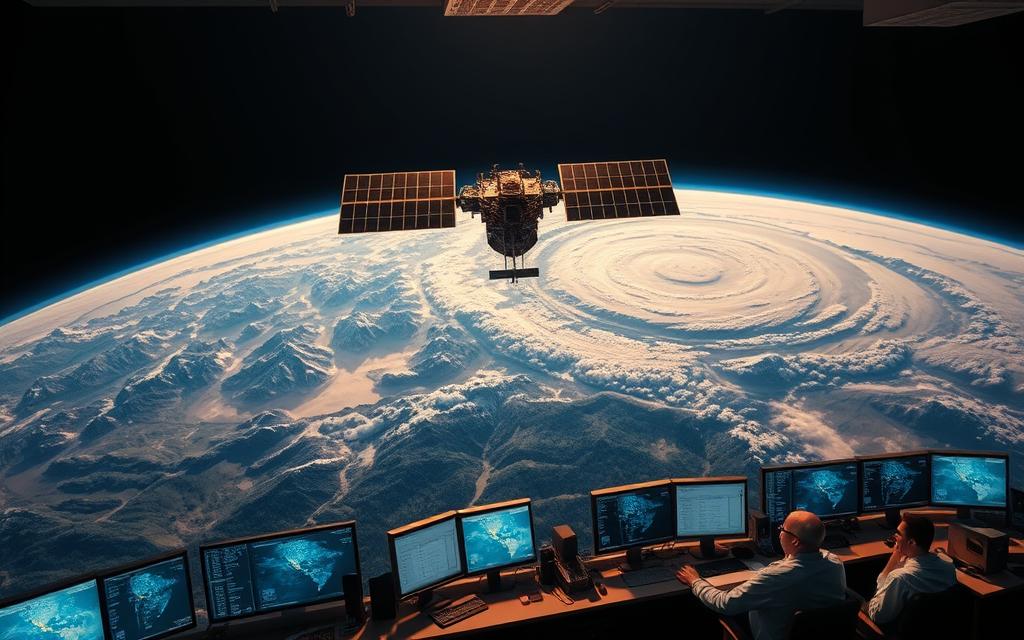
AI-powered Disaster Response Systems
Disaster prediction algorithms are changing how we get ready for emergencies. Google’s DeepMind has made a model for Bangladesh that warns of floods 7 days in advance with 90% accuracy. These models look at:
- Real-time weather satellite data
- Historical flood patterns
- Urban infrastructure vulnerabilities
The UN Office for Disaster Risk Reduction says AI tools have cut flood deaths by 35% in some areas since 2021.
Blockchain for Transparent Aid Distribution
Blockchain philanthropy is making aid distribution fairer. Oxfam’s test in Syria used blockchain to:
- Track donations from start to finish
- Make aid delivery automatic
- Keep records up to date
“Our blockchain system cut down on costs by 17% and sped up aid delivery by 40%”
Satellite Monitoring of Climate Patterns
The European Space Agency’s Copernicus programme tracks Arctic ice with 2cm accuracy. It helps with:
- Understanding how sea levels will rise
- Spotting illegal deforestation
- Finding methane leaks
This info helps shape climate policies in 38 countries. It shows how space tech helps us make better decisions on Earth.
Conclusion
Technology has changed healthcare, education, and how we live sustainably. It has brought new ways to do things, like AI in surgery and IoT in farming. But, as UA Grantham’s research shows, we must use these tools wisely to avoid problems like too much screen time or data breaches.
It’s important to innovate responsibly, especially with 5G and AI. Companies like DYOPATH focus on keeping data safe, following Ofcom’s advice on digital health. The UN’s guidelines on AI show how working together can lead to fair digital futures.
We need to be open about how technology works, especially in finance and aid. By making policies that adapt to new tech, we can make sure it helps us, not hinders. For example, AI is helping make vaccines and respond to disasters, but we must consider ethics.
We must work together, with governments, businesses, and communities. By using technology wisely in areas like climate and education, we can make progress and protect privacy and mental health. This way, we can turn potential dangers into chances for growth, where technology and responsibility go hand in hand.
